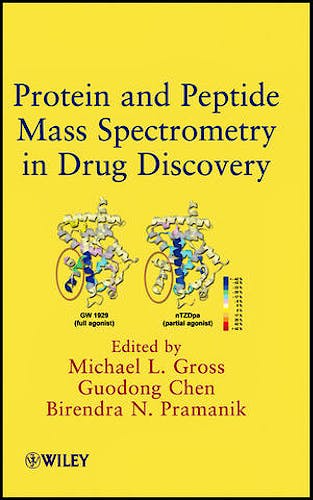

No hay productos en el carrito



Protein and Peptide Mass Spectrometry in Drug Discovery
Gross, M. — Chen, G. — Pramanik, B.
1ª Edición Diciembre 2011
Inglés
Tapa dura
496 pags
1400 gr
null x null x null cm
ISBN 9780470258170
Editorial WILEY
LIBRO IMPRESO
-5%
162,56 €154,43 €IVA incluido
156,31 €148,49 €IVA no incluido
Recíbelo en un plazo de
2 - 3 semanas
LIBRO ELECTRÓNICO
-5%
143,51 €136,33 €IVA incluido
137,99 €131,09 €IVA no incluido
Acceso On Line
Inmediato
DESCRIPTION
The book that highlights mass spectrometry and its application in characterizing proteins and peptides in drug discovery
An instrumental analytical method for quantifying the mass and characterization of various samples from small molecules to large proteins, mass spectrometry (MS) has become one of the most widely used techniques for studying proteins and peptides over the last decade. Bringing together the work of experts in academia and industry, Protein and Peptide Mass Spectrometry in Drug Discovery highlights current analytical approaches, industry practices, and modern strategies for the characterization of both peptides and proteins in drug discovery.
Illustrating the critical role MS technology plays in characterizing target proteins and protein products, the methods used, ion mobility, and the use of microwave radiation to speed proteolysis, the book also covers important emerging applications for neuroproteomics and antigenic peptides. Placing an emphasis on the pharmaceutical industry, the book stresses practice and applications, presenting real-world examples covering the most recent advances in mass spectrometry, and providing an invaluable resource for pharmaceutical scientists in industry and academia, analytical and bioanalytical chemists, and researchers in protein science and proteomics.
TABLE OF CONTENTS
- Preface.
- Contributors.
Part I. Methodology.
- 1.Ionization Methods in Protein Mass Spectrometry (Ismael Cotte-Rodriguez, Yun Zhang, Zhixin Miao and Hao Chen).
- History of the development of protein mass spectrometry.
- Laser based ionization methods for proteins.
- Spray-based ionization methods for proteins.
- Ambient ionization methods.
- Conclusions.
- 2. Ion Activation and Mass Analysis in Protein Mass Spectrometry (Cheng Lin and Peter O’Connor).
- Introduction.
- Ion Activation and Tandem MS Analysis.
- Mass Analyzers.
- 3. Target Proteins: Bottom-up and Top-down Proteomics (Michael Boyne and Ron Bose).
- Mass Spectral Approaches to Targeted Protein Identification.
- Bottom-up Proteomics.
- Top-down Approaches.
- Next generation approaches.
- 4. Quantitative Proteomics by Mass Spectrometry (Jacob Galan, Anton Iliuk and W. Andy Tao).
- Introduction.
- In-cell Labeling.
- Quantitation via Isotopic Labeling of Proteins.
- Quantitation via Isotopic Labeling on Peptides.
- Label-free Quantitation.
- Conclusions.
- Acknowledgment.
- 5. Comparative Proteomics by Direct Tissue Analysis using Imaging Mass Spectrometry (Michelle L. Reyzer and Richard M. Caprioli).
- Introduction.
- Conventional Comparative Proteomics.
- Comparative Proteomics using Imaging MS.
- Conclusions.
- Acknowledgements.
- 6. Peptide and Protein Analysis using Ion Mobility-Mass Spectrometry (Jeffrey R. Enders, Michal Kliman, Sevugarajan Sundarapandian and John A. McLean).
- Ion Mobility-Mass Spectrometry: Instrumentation and Separation Selectivity.
- Characterizing and Interpreting Peptide and Protein Structure.
- Applications of IM-MS to Peptide and Protein Characterization.
- Future Directions.
- 7. Chemical Footprinting for Determining Protein Properties and Interactions (Sandra A. Kerfoot and Michael L. Gross).
- Introduction to Hydrogen/Deuterium Exchange.
- Experimental Procedures.
- Mass Spectrometry-based HDX in Practice.
- Protein footprinting via Free-radical Oxidation.
- Chemical Cross Linking.
- Selective and Irreversible Chemical Modification.
- Conclusion.
- 8. Microwave Technology to Accelerate Protein Analysis (Urooj A. Mirza, Birendra N. Pramanik and Ajay K. Bose).
- Introduction.
- Microwave Technology.
- Summary.
- Acknowledgements.
- 9. Bioinformatics and Database Searching (Surendra Dasari and David L. Tabb).
- Overview.
- Introduction to Tandem Mass Spectrometry.
- Overview of Peptide Identification with Database Searching.
- MyriMatch-IDPicker Protein Identification Pipline.
- Results of a Shotgun Proteomics Study.
- Improvements to MyriMatch DatabaseSearch Engine.
- Applications of MyriMatch-IDPicker Pipeline.
- Conclusion.
- Acknowledgements.
Part II. Application.
- 10. Mass Spectrometry-based Screening and Characterization of Protein – Ligand Complexes in Drug Discovery (Christine L. Andrews, Michael R. Ziebell, Elliott Nickbarg and Xianshu Yang).
- Introduction.
- Affinity Selection Mass Spectrometry (AS-MS).
- Solution-based AS-MS as Screening Technologies.
- Gas-Phase Interactions.
- Enzyme Activity Assays using MS for Screening or Confirming Drug Candidates.
- Conclusions and Future Directions.
- 11. Utilization of Mass Spectrometry for the Structural Characterization of Biopharmaceutical Protein Products (Amareth Lim and Catherine A. Srebalus Barnes).
- Introduction.
- MS-Based Approach for the Characterization of Recombinant Therapeutic Proteins.
- Cell Culture Development.
- Purification Development.
- Formulation Development.
- Analytical Method Development.
- Confirmation of Structure/Product Comparability Assessment.
- Conclusions.
- 12. Post-Translationally Modified Proteins: Glycosylation, Phosphorylation, and Disulfide Bond Formation (Anthony Tsarbopoulos and Fotini N. Bazoti).
- Introduction.
- Glycosylation.
- Phosphorylation.
- Disulfide Bond Detection and Mapping.
- Future Perspectives.
- 13. Mass Spectrometry of Antigenic Peptides (Henry Rohrs).
- Introduction.
- Analysis of Antigenic Peptides.
- Examples of the Application of Mass Spectrometry to Antigenic Peptide Study.
- Future.
- 14. Neuropeptidomics Jonathan V. Sweedler, Fang Xie and Adriana Bora).
- Introduction.
- Neuropeptidomics: Characterizing Peptides in the Brain.
- Sample Preparation for Mass Spectrometry.
- Separations.
- Peptide Characterization via Mass Spectrometry.
- Conclusions.
- Future Perspectives.
- Acknowledgements.
- 15. Mass Spectrometry for the Study of Peptide Drug Metabolism (Patrick J. Rudewics).
- Introduction.
- Peptide Drug Metabolism.
- LC-MS/MS for Metabolite Identification.
- Quantitative Analysis.
- Case Study: Il-1ß Protease Inhibitors.
- Future Directions.
AUTHOR
Michael L. Gross, PhD, is a Professor in the Departments of Chemistry, Medicine, and Immunology at Washington University in St. Louis. He is also Principal Investigator at the National Institutes of Health (NIH) Research Resource in Mass Spectrometry.
Guodong Chen, PhD, is Principal Scientist in Bioanalytical and Discovery Analytical Sciences at Bristol-Myers Squibb in Princeton, New Jersey. He heads a mass spectrometry group in support of drug discovery as well as development programs in small molecule pharmaceuticals and biologics.
Birendra N. Pramanik, PhD, was a Distinguished Fellow at Schering-Plough Research Institute (SPRI), where he directed the spectroscopy, mass spectrometry, and NMR programs.
© 2025 Axón Librería S.L.
2.149.0